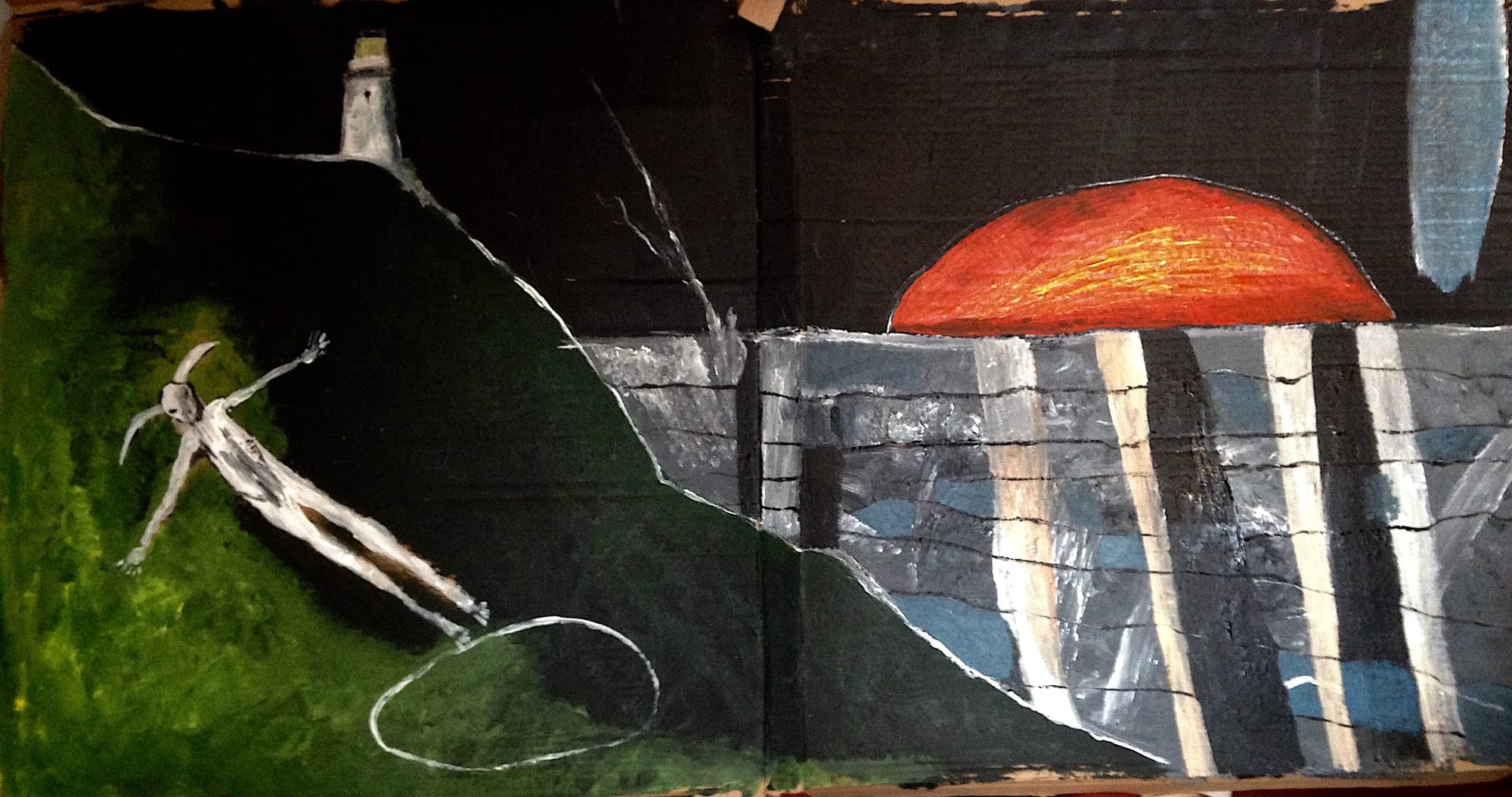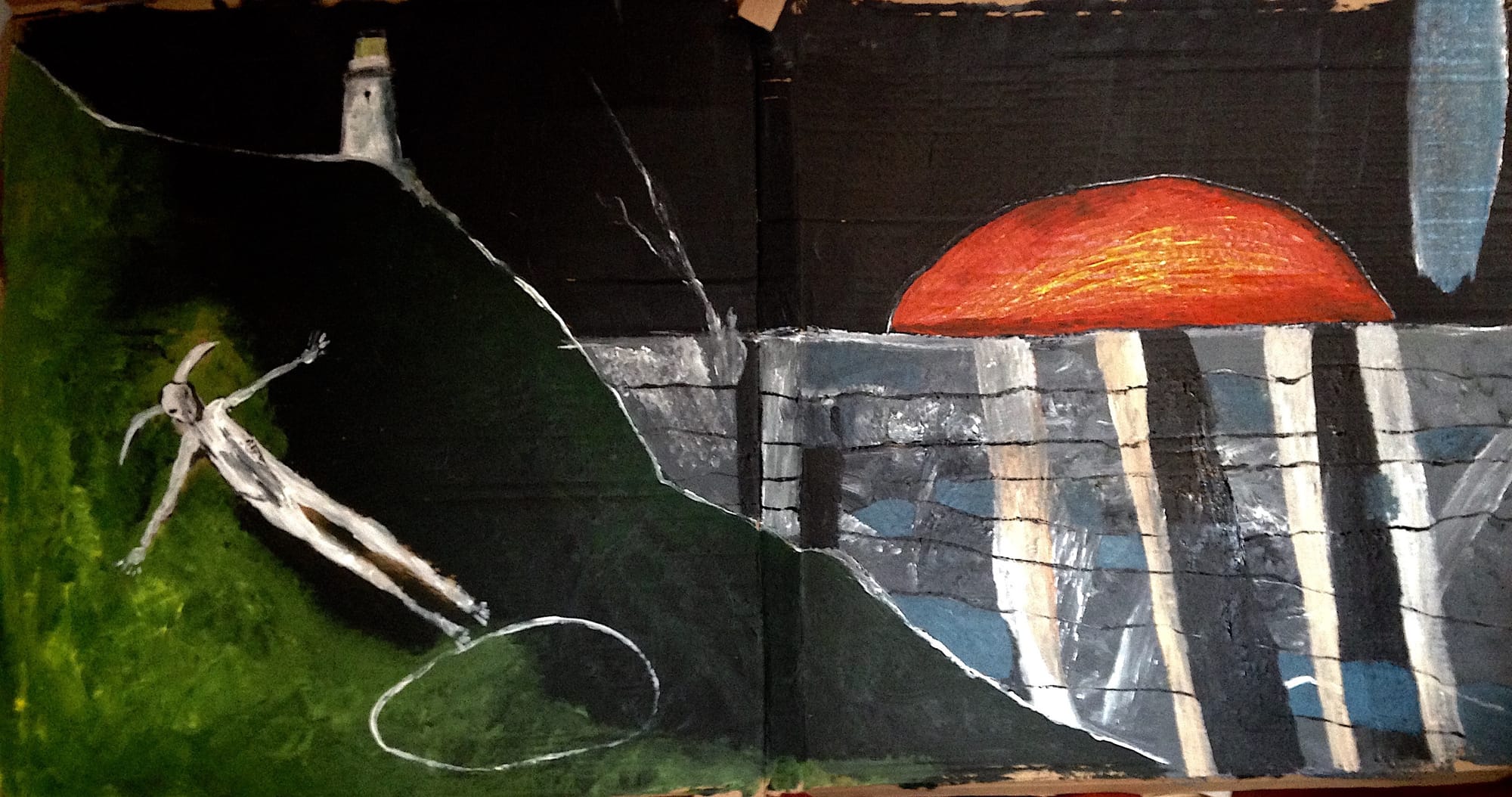47094: 48 Meeting the Multitudinous Birds

She hurried on into the long grass between the trees that jammed up into the sky and its darkness, large and shaky. A cormorant-eyed woman staggered with paper bags, her muscles controlled, her pupils contracted black pin-pricks, and her ears tiny slits and without external nostrils, as if a diver, smooth sided and unserrated, an enormous gape with no writhing, finely tuned holding long neck and legs haughtily far back, so able to perch, narrow pelvised with long bony processes well enough for her bulky leg muscles, steered and moving in powerful thrusts, stiff as a rudder, forward facing and dense boned, positively sinkable and kinky.
Our woman walked. The earth began to fall away. She swirled up into the vast sky and met the multitudinous birds. The gull is cosmopolitan, adaptable, omnivorous, opportunistic, running and walking, at home everywhere – water, land, gregarious with oiled eyes filtering out sun haze, long visioned and long necked, wide necked. The tern is slender, longer, never swims, isn’t even waterproof, a specialised aquatic, eating just fish or sea animals except marshland fliers, bill snapping, tactile not visual, foragering, deep breastboned, some with shorter necks, talons, a hook-tipped skimmer.
The flamingo’s feather parasites are like geese parasites, and the bird’s long, thin-legged, long necked, soft tissued, smooth curved, bony like dot-to-dot puzzles, boomerang billed, sharp angled and downward in the middle, filter feeding like baleen whales, eating algae, molluscs, with comb-like, hairy lamella traps, in inhospitable lagoons and saline and soda lakes with twice the salt content of oceans, drinking water at boiling point, excreting salt from glands ejected via bills, she's the phoenix and utterly strange.
A heron’s neck is permanently kinked on a hinge mechanism, has well-developed backward pointing spines, monocular vision all round, plus binocular vision ahead and below, crouched or upright, serrated, a pectinated inner edge to their middle claw, preening and cleaning, feather barbs, oily preen glands and power down clumps, they’re killers.
Showbills are rare, shy, bulky and large-headed, stealthy with a bill that engulfs victims and acts as a shock-absorber. Storks are murky, swampy, bills are highly sensitive, are strong fliers, have a deep rounded keel, forearms greatly exceed their upper arms, are top-heavy strong, have muscles anchored to the vertebrae between shoulders, hunchbacked, closer to new world vultures than herons, ibis or spoonbills. See the vulturesque stork or insane Marabou.
The Sarus Crane is the tallest of all fliers, without the z shaped kink, and dances at the slightest provocation, with an extensive repertoire of vocal communication, bugling via elongated windpipe or tracea, maybe resonating in its breastbone like the body of a violin. An inflatable throat-sac makes the whoop of Whooping Cranes where a windpipe forms a double-loop extending the length of the breastbone, not in the shallow depression at the front of the keel like the rest.
Rails skulk in dense places, thin and deep silhouettes that disappear head-on, with snippy bills, violently strong legs, thigh bones with knees well forward beneath the body giving a horizontal stance when walking. They can swim and walk, are most cosmopolitan , and are mainly flightless.
The woodcock flies zigzag, its skull orientated through 90 degrees like a human head with its neck joining underneath not behind, its braincase tucked in at the back, eyes projected well above the level of the cranium. With sensitive bill tips they feed by touch, grip prey with just the point because of nostrils too elongated in their three strips of bone, one on top and the other two on the sides and has elsewhere an elastic stretch of flexible bony tissue which can go up and out.
Plovers have extra rods in their eyes so can see in the dinge but they lose most colour discrimination. Owls have predator features, nocturnal fleshy cere surrounding their nostrils, hooked talons and beaks, strong legs and angled pelvis for feet hunting, with long fibula toothpick spines of bone on outer side of legs helping them to rotate feet, with short toes all thick and chunky, counting two or three toes like toucans and parrots at a wide gape; and they regurgitate pellets, have low body weight and an especially small body, a well developed keel but small breastbones, are silent fliers whose beatings are muffled by soft fringes and downy surfaces and comb-like leading edges, unless fish eaters because fish are deaf, and these have bare unfeathered tarsi and raised spiny scales on their feet like ospreys. Barn owls and Bay owls contrast the typical: Barns are narrow-faced like a heart whilst typicals are rounded and bulbous, not tapered, nor elongated. Forward-facing eyes and fat faces, with eyes angled slightly apart a little , they bob to compensate for narrow binocular angle and judge distances accurately. Eyes are immobile so necks are super-flexible, can turn almost full circle, and huge eyes have a high density of rods in retinas with wide pupils, so they see better than humans at night but worse than cat or nightjar, lacking tapetum which is what night vision really needs, but with excellent memories for spatial details. Large ears are within facial discs, and asymmetrical for time lapses between right and left sides to pinpoint doomed targets no matter where buried, leaf litter, snow mound or the dead of a night dark.

Read 47094 from the beginning here.
Read the complete novel 'The Ecstatic Silence' here.